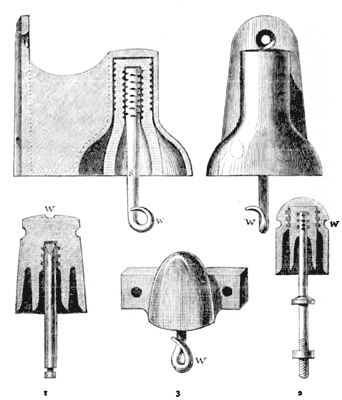[Trade Journal]
Publication: Electricity and Magnetism
London, England
p. 343-345, col. 1
No line can be perfectly insulated. On land lines no leakage occurs from the wire to the air, but at every pole there must with the best construction be some leakage, or, in other words, at every pole there is a connection with the earth. The resistance of this connection is very great when the wire is well insulated, and small when there is bad insulation.
The wire is always separated from the wooden pole by an insulator, and the insulation of the wire depends on the design, material, and condition of these insulators. Glass of certain kinds offers the greatest resistance to conduction through its substance of any known material, but it does not answer well for telegraphic insulation, because surface conduction plays by far the greatest part in the leakage from a line, and glass is highly hygroscopic, i.e. it will be found covered with a moist film in most states of the weather. Ebonite (hard vulcanized india-rubber) has a high insulation resistance and does not readily become damp, but rain wets it easily, and therefore when employed for insulators it is generally covered with a cap of some other material: it soon becomes dirty and spongy on the surface.
Porcelain of certain qualities insulates well; it is not nearly so hygroscopic as glass, and rain runs readily from its highly glazed surface. The glaze insulates still better than the substance of the porcelain, but in some specimens is liable to crack with old age, when its value is lost.
Brown stoneware is an excellent and cheap material for insulators: its glaze does not crack, but its substance has not so great a specific resistance as highly vitrified porcelain. The point of chief importance in all insulators being the condition of the surface, porcelain and stoneware are the favourite materials; they keep clean, do not change with age if well selected, and do not harbour insects.
The form most used approaches that of a bell, or of several bells one inside another. In Fig. 167 No. 1 shows Latimer Clark's double-bell insulator; No. 2 Varley's insulator, made in two pieces; No. 3 the French cup insulator, a very rudimentary design; and No. 4 Siemens' insulator, protected and supported by an iron cap.
 |
The objects aimed at in each design are the following:—
1. To make any conducting film which may be deposited on the surface of the insulator between the wire and the pole as long as possible, because, other things being equal, its resistance increases directly as its length. This object is attained by the series of bells, for the electricity has to run down outside and up inside each, in succession, before getting from the wire to the pole.
2. To make the cross section of the conducting film as small as possible. With this object the insulator is kept as small in diameter as is consistent with other conditions of excellence.
The thickness of the deposited conducting film depends on external conditions, but the larger the diameter of our bells the larger will be the cross section of the film, i.e. the ring of moisture which we should find outside and inside each ring of insulating material if it were sawn across horizontally.
3. To expose one portion of the insulator to the rain, so that it may be cleansed by rain from dust, salt, smoke, spiders-webs, &c.
4. To protect another portion of the insulator from rain, so that when the outside is wet the inside may still insulate. These two conditions are fulfilled by the forms 1 and 2.
5. To prevent the failure of part of the insulator from destroying the insulation. With this object some good insulators are made in three parts, as shown in Fig. 2—two distinct cups and a vulcanite covering to the iron supporting pin.
6. To prevent insects from settling in recesses. This object is difficult of attainment, and limits the depths of the recesses under the bells.
7. To provide strength and protection against malicious injury. This leads to the adoption of metal caps as in Fig. 4.
